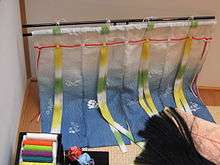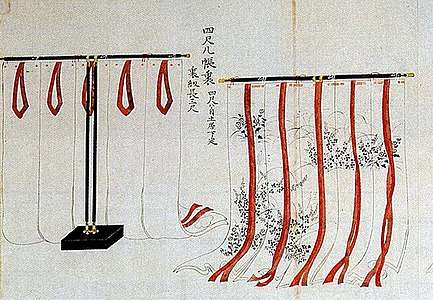Kichō
A kichō (几帳) is a portable multi-paneled silk partition supported by a T-pole.[1] It came into use in aristocratic households during and following the Heian period in Japan[2] when it became a standard piece of furniture.[3] They are similar in appearance to a kabeshiro (壁代, wall-curtain), but are mounted on a free-standing stand rather than a lintel beam. They are less similar to noren, which do not include streamers to tie them up, and are generally used in different social settings.

The kichō is often placed just on the inside of bamboo blinds, forming a portable double privacy barrier to the outside of the house. They are also used as portable room dividers inside the house.[4] Today, they are most often used as decorations or to hide boxes or other unsightly messes in a home.
In former times, they would often be used to hide noble women from public eyes when they visited shrines or temples, and to provide additional privacy for the women at home.[5] Smaller versions called sashikichō (差几帳) were carried by the female attendants of a noble woman in order to hide her from public view while she traveled.
In the 1880s (late Edo period), they were rare, but possibly still used in the houses of daimios.[6]
 A kichō curtain, called a katabira (帷)[7] is made from parallel lengths of narrow-loom cloth (tanmono). The streamers may be used to tie it up.
A kichō curtain, called a katabira (帷)[7] is made from parallel lengths of narrow-loom cloth (tanmono). The streamers may be used to tie it up.- Kichōs used behind sudare blinds for gender segregation; the sleeves of the women protrude from behind the screens, while the men sit on the engawa outside. 1200s illustration.
 Imperial apartments. Empress Shōshi, her infant son Atsuhira, and an unidentified lady are screened by kichōs. Below, her father Fujiwara no Michinaga and her lady-in-waiting, likely Murasaki Shikibu.
Imperial apartments. Empress Shōshi, her infant son Atsuhira, and an unidentified lady are screened by kichōs. Below, her father Fujiwara no Michinaga and her lady-in-waiting, likely Murasaki Shikibu.
See also
References
- Ueda, Atsushi (1990). The Inner Harmony of the Japanese House. Stephen Suloway (translator). Kodansha International. pp. 66–67. ISBN 4-7700-2353-7.
- 几帳(きちょう) [Kichō] (in Japanese). 人形のこうげつTAKASAKI. Archived from the original on August 18, 2011. Retrieved August 18, 2011.
- Murasaki, Shikibu (October 11, 2001). "General Glossary". The Tale of Genji. Royall Tyler (translator). Viking Press. p. 1151. ISBN 0-670-03020-1.
- Frédéric, Louis (April 30, 2005). Japan Encyclopedia. Käthe Roth (translator). Belknap Press of Harvard University Press. p. 514. ISBN 0-674-01753-6. Retrieved August 18, 2011.
- Sei, Shōnagon (April 15, 1991). The Pillow Book of Sei Shōnagon. Ivan I. Morris (translator). Columbia University Press. p. 288. ISBN 0-231-07337-2.
- Morse, Edward S. (1885). "3: Interiors". Japanese Homes and their Surroundings. Charles E. Tuttle Company. ISBN 0-8048-0998-4.
- "JAANUS / katabira 帷". www.aisf.or.jp.